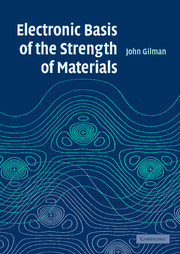Book contents
- Frontmatter
- Contents
- Preface
- Section I Introduction
- Section II Elements of solid mechanics
- Section III Elements of electron mechanics
- Section IV Elastic stiffness
- Section V Plastic strength
- Section VI Fracture resistance
- 19 Mechanics of cracks
- 20 Surface and interfacial energies
- 21 Fracturing rates
- Index
- References
20 - Surface and interfacial energies
Published online by Cambridge University Press: 14 August 2009
- Frontmatter
- Contents
- Preface
- Section I Introduction
- Section II Elements of solid mechanics
- Section III Elements of electron mechanics
- Section IV Elastic stiffness
- Section V Plastic strength
- Section VI Fracture resistance
- 19 Mechanics of cracks
- 20 Surface and interfacial energies
- 21 Fracturing rates
- Index
- References
Summary
Introduction
In the last Chapter the intimate connection between fracture and surface energy was discussed for both the ideal and non-ideal cases. The discussion indicated the primary role played by the intrinsic surface energy, S. Now the connection of S to the electronic properties of materials will be emphasized, including the energies of interfaces. Recognizing that all such theories are approximate, only the most simple analytic theories will be presented with brief mention of detailed computer-based but approximate theories. These are sometimes said to be “first principles theories”, but they are no more based on “first principles” than other approximate theories based on quantum mechanics. The Heisenberg Theorem ensures this, by limiting the basis of any theory. Also, as this book has mentioned previously, few experimental measurements are accurate enough to justify the application of a high precision theory.
Of general interest is the pattern of surface energies throughout the Periodic Table of the Elements (Figure 20.1). Most of the data are for liquids and are from Murr (1975) and Allen (1972). An obvious exception is the value for diamond which comes from cleavage experiments. Also note that, in the solid state, anisotropic substances like Se have more than one surface energy; one of them is much larger than the value given in the figure, and the other is about the same as the given value. The gaps (e.g., atomic numbers 7–10) are simply places where there are no measured surface energies.
- Type
- Chapter
- Information
- Electronic Basis of the Strength of Materials , pp. 254 - 266Publisher: Cambridge University PressPrint publication year: 2003

